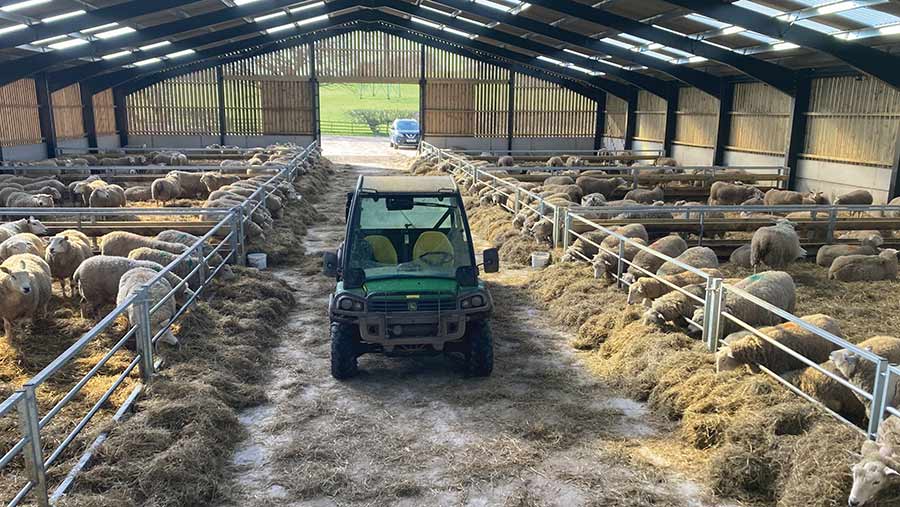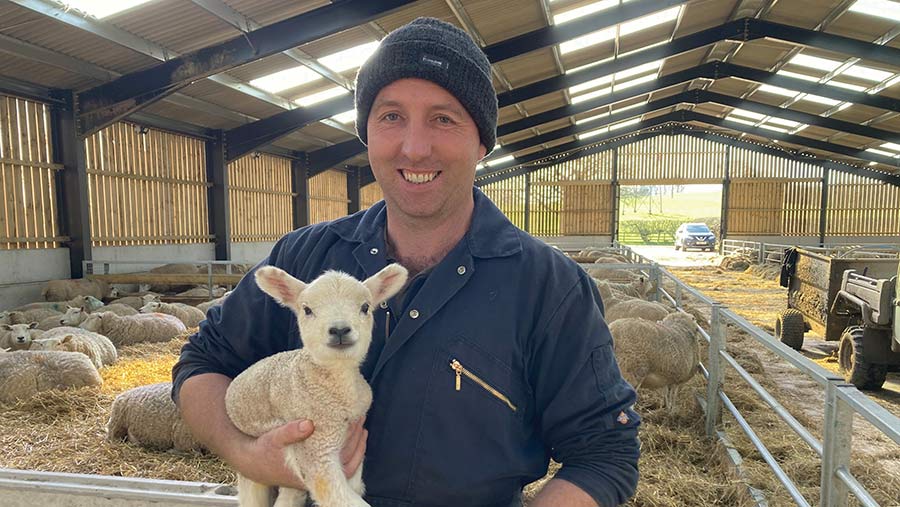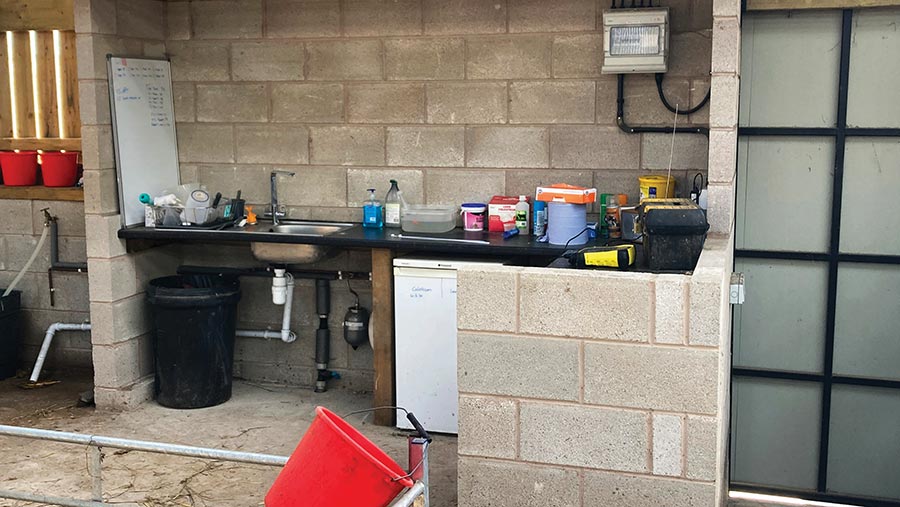How colostrum and new shed helped cut lamb mortality
 © MAG/Michael Priestley
© MAG/Michael Priestley Meticulous colostrum feeding and a new lambing shed have helped cut mortality and eradicate cases of watery mouth in an organic March-lambing flock.
Mortality has fallen from 26% to 17% and there was only one case of watery mouth last year at the farm on the borders of Cheshire, Shropshire and Wales.
The organic beef and sheep business, based in Tushingham, Whitchurch, is managed by Fiona Young, with help from her husband, David, a former army officer.
They have employed Dylan Williams, originally from the Lleyn peninsula, to manage the stock since 2018.
See also: Video: How farmer lambs 1,000 ewes inside without oral antibiotics
Farm facts
- 131ha of organic grassland spread over three farms
- Reseeding with herbal leys
- 468 ewes to lamb this year
- 24 South Devon suckler cows
- Most stock sold to ABP on organic contract
- Scanning at 162%
- Historically rearing 123%
Previous setup
The farm used to lamb in four small sheds, including a dilapidated cattle shed and a Nissen hut, around a traditional Cheshire farmyard.
“This involved removing ewes every time straw or hay was added to some sheds and wading through sheep with a 25kg bag of feed in others,” explains Dylan.
The flock had outgrown this setup. Lambing labour was inefficient, and the team relied on a regular oral dose of antibiotics on 30-40 smaller, weaker lambs and triplets. Mortality from scanning to weaning was 20-30%.

© MAG/Michael Priestley
New shed
This lambing season is the second the Youngs have used the new shed, and managed without the oral antibiotic spectinomycin (Spectam) for watery mouth, since it was taken off the market.
Fiona stresses the shed – which cost about £150,000 fully fitted out – is crucial as lambing outdoors on their heavy clay soil would be hugely challenging.
It was funded without grant money from cash generated outside the business.
“On a family farm, I think you have to bite the bullet to safeguard the future,” she says. “We only wish we’d done it earlier.”
The old buildings are now used as turnout pens, so lambs are at least a week old before heading to grass. This is to limit fox and badger predation.
Other shed benefits
- Roomy, light and airy The shed layout works very well for farm visits. David runs a farm-based day services centre for young people with learning disabilities called Rooted and Booted. They also welcome school children on educational farm tours, benefiting from the educational access option in Countryside Stewardship.
- Everything in one place Feed, water, cleaning materials and lambing gear are all in one shed, saving time on walking round the yard. All sheep can be seen at once.
- Speed of feeding and bedding A McHale straw chopper is used to shred silage to be forked along the feed face to feed all the sheep in 10 minutes.
Shed specifications and system
Building
- Designed to own specification
- About 300t of soil and rock (from a previous shed building) used to create a flat base with natural drainage
- Erection of shed and concreting for central feed passage done by local contractors
- Kitchen, internal walls, interior steelwork and remaining concrete walkways done in-house
Design
- Steel frame, Yorkshire boarding and concrete panel sides
- 48x23m dimension with a 5m central passage
- Protected open ridge along roof
- Four skylight roof panels and electric lights with individual switch for each bay
Pens
- Eight main pre-lambing, loose housed yards, using bought-in straw
- Bespoke steelwork
- Pre-lambing ewes watered by trough with automatic filling on a ball valve
- Room for 400 ewes according to Soil Association spacing
- 50 individual mothering pens for ewes and lambs to bond, watered with buckets
- Four hospital pens placed next to two double sockets for plugging in heat lamps
Kitchen
- Hot and cold water supplied to a small kitchen near the individual pens
- Workstation fitted with a sink and draining board, a fridge, power points and wipe-down sides
- Wall-mounted whiteboard used to relay messages and direct people to certain pens

© MAG/Michael Priestley
System
- Pre-lambing, ewes fed a ewe nut and high-quality silage for six weeks
- Sheep housed in stages from early January, starting with thin and triplet-bearing ewes
- Silage, cake and Himalayan rock salt fed to each pen via a central feed passage with walk-through feed rack
- Mineral buckets offered to each pen
- Dylan Williams (employed full-time) lambs the sheep, Fiona Young looks after the mothering pens and husband David helps out as required
Colostrum feeding
Every ewe is milked with an Udderley EZ teat pumping device. Lambs are fed 120ml of colostrum in one go to ensure they have a good start in life.
Providing everything looks well, they are left to find the teat themselves thereafter.
Only one case of watery mouth was seen last year, in 740 lambs. “I simply forgot to feed [that] one lamb,” says Dylan. “It shows how important colostrum is.”
The lamb survived after a rehydration drink and a jab of antibiotics.
Colostrum is stored in a jug in a fridge, with some frozen in ramekins to top up lambs on ewes with less milk.
Once a ewe has been milked and her lambs fed, a blue spot of stock marker is sprayed on her head.
Dylan has noticed that colostrum-fed lambs are stronger at turnout. The team says the following factors are key for controlling losses and antibiotics use:
- Cleanliness Every pen is mucked out to the floor. Lime powder is sprinkled, and the pen is left to dry for as long as possible.
- Vaccination This gives protection against toxoplasmosis and enzootic abortion.
- Attention to issues Laminated cards with “A” (adopted lamb), “S” (needs help suckling) or “X” (miscellaneous problems) keep track of sheep needing extra care. Miscellaneous problems are detailed on the shed kitchen whiteboard. Every card is numbered to help identify pens.
- Condition scoring Dylan groups and condition-scores ewes at weaning, tupping and housing to manage condition and help support colostrum production.
- Genetics The flock has been closed for five years. Having performance-recorded Lleyns from Peregrine Aubrey and maternal, forage-reared Texels from Robin Hulme is helping improve lamb rearing rates.
Future aims
- Raise scanning to 185% and rear 170% by selecting twins for breeding
- Further improve scanning rates by breeding replacements as shearlings not ewe lambs: the farm found gimmers scanned at 167%, 31% higher than shearlings bred as ewe lambs
- Increase flock size: the current growth trajectory will see it reach about 700 head by 2026
- Use genetics and management improvements to further raise productivity. All causes of mortality and related issues are recorded on Tru-Test Datamars to inform culling and selection
- Save on feed costs by replacing concentrate feed to ewe lambs with herbal ley silage. This will be a major saving, as organic ewe rolls are £537/t
- Pay off the new shed – if the farm hits its targets, this will happen by the end of 2028
